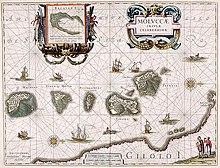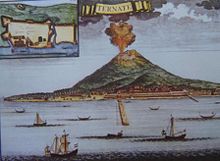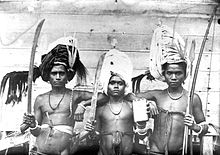Maluku Islands
Nuaulu, Bugis |
The Maluku Islands (/məˈluːkuː, mæˈluːkuː/; Indonesian: Kepulauan Maluku) or the Moluccas (/məˈlʌkəz/) are an archipelago in the eastern part of Indonesia. Tectonically they are located on the Halmahera Plate within the Molucca Sea Collision Zone. Geographically they are located east of Sulawesi, west of New Guinea, and north and east of Timor. Lying within Wallacea (mostly east of the biogeographical Weber Line), the Moluccas have been considered a geographical and cultural intersection of Asia and Oceania.
The islands were known as the Spice Islands because of the nutmeg, mace, and cloves that were exclusively found there, the presence of which sparked European colonial interests in the 16th century.[3]
The Maluku Islands formed a single
Etymology
The etymology of the word Maluku is unclear and has been a matter of debate for many experts.[6]
The first recorded word that can be identified with Maluku comes from Nagarakretagama, an Old Javanese eulogy of 1365. Canto 14 stanza 5 mentioned Maloko, which Pigeaud identified with Ternate or Moluccas.[7]: 17 [8]: 34
A theory holds that Maluku comes from the phrase Moloko Kie Raha or Moloku Kie Raha. In the Ternate language, raha means "four", while kie here means "mountain". Kie raha or "four mountains" refers to Ternate, Tidore, Bacan, and Jailolo (the name Jailolo has been used in the past to refer to Halmahera island), all of which have their kolano (a local title for kings rooted in Panji tales).[9]
It is unclear what the meaning of Moloko or Moloku is. One possible meaning is in Ternate language, it meant "to hold or grasp", in which case Moloko Kie Raha could be understood to mean "Confederation of the Four Mountains". Another possibility is that the word originates from the word maloko, which is a combination of the particle ma- and the root loko in North Halmahera languages means the variety of words relating to the location of mountains, in which case "Maloko Kie Raha" in the phrase "Ternate se Tidore, Moti se Mara Maloko Kie Raha" means "Ternate, Tidore, Moti, and Mara the place of the four mountains" or with the shifting of pronunciation of loko towards luku, means "Ternate, Tidore, Moti, and Mara the world of the four mountains".[10]
History

Early history
Australo-Melanesians were the first people to inhabit the islands at least 40,000 years ago, and then a later migration of Austronesian speakers around 2000 BC.
Portuguese


In August 1511 the Portuguese conquered the city-state of Malacca. The most significant lasting effects of the Portuguese presence were the disruption and reorganization of the Southeast Asian trade, and in eastern Indonesia—including Maluku—the introduction of Christianity.[15]
One Portuguese diary noted, "It is over thirty years since they became Moors".[16]
Allying himself with Ternate's ruler, Serrão constructed a fortress on that tiny island and served as the head of a
Following Portuguese missionary work, there have been large Christian communities in eastern Indonesia through to contemporary times, which has contributed to a sense of shared interest with Europeans, particularly among the Ambonese.[19]

Dutch
The Dutch arrived in 1599 and competed with the Portuguese in the area for trade.

After Indonesian independence
With the declaration of a single republic of
Maluku is one of the first provinces of Indonesia, proclaimed in 1945 and lasting until 1999 when the Maluku Utara and Halmahera Tengah Regencies were split off as a separate province of North Maluku. Its capital used to be Ternate, on a small island to the west of the large island of Halmahera, but has been moved to Sofifi on Halmahera itself. The capital of the remaining part of Maluku province remains at Ambon.[citation needed]
1999–2003 inter-communal conflict
Religious and ethnic conflict erupted across the islands in January 1999. The subsequent 18 months were characterized by fighting between local groups of Muslims and Christians against jihadist groups from Java and the Indonesian military backing them leading to the destruction of thousands of houses, the displacement of approximately 500,000 people, the loss of thousands of lives, and the segregation of Muslims and Christians.[22]
Geography

The Maluku Islands have a total area of 850,000 km2 (330,000 sq mi), 90% of which is sea.
The majority of the islands are forested and mountainous. The Tanimbar Islands are dry and hilly, while the Aru Islands are flat and swampy. Mount Binaiya (3,027 m; 9,931 ft) on Seram is the highest mountain. Several islands, such as Ternate (1,721 m; 5,646 ft) and the TNS islands, are volcanoes emerging from the sea with villages sited around their coasts. There have been over 70 serious volcanic eruptions in the last 500 years and earthquakes are common.[24]

Geology
The geology of the Maluku Islands shares much similar history, characteristics, and processes with the neighbouring Nusa Tenggara region. There is a long history of geological study of these regions since Indonesian colonial times; however, the geological formation and progression are not fully understood, and theories of the island's geological evolution have changed extensively in recent decades.[25] The Maluku Islands comprise some of the most geologically complex and active regions in the world,[26] resulting from their position at the meeting point of four geological plates and two continental blocks.
Ecology
The ecology of the Maluku Islands has fascinated naturalists for centuries;
Rainforest covered most of northern and central Maluku, which, on the smaller islands has been replaced by plantations, including the region's endemic
Nocturnal
While many ecological problems affect both small islands and large landmasses, small islands suffer their particular problems. Development pressures on small islands are increasing, although their effects are not always anticipated. Although Indonesia is richly endowed with natural resources, the resources of the small islands of Maluku are limited and specialised; furthermore, human resources, in particular, are limited.[28]
General observations[29][30] about small islands that can be applied to the Maluku Islands include:[28]
- A higher proportion of the landmass will be affected by volcanic activity, earthquakes, landslips, and cyclone damage;
- Climates are more likely to be maritimeinfluenced;
- Catchment areas are smaller and the degree of erosion higher;
- A higher proportion of the landmass is made up of coastal areas;
- A higher degree of environmental specialisation, including a higher proportion of depauperatecommunity;
- Societies may retain a strong sense of culture having developed in relative isolation;
- Small island populations are more likely to be affected by economic migration.
Climate
Central and southern Maluku Islands experience the dry monsoon between October and March and the wet monsoon from May to August, which is the reverse of the rest of Indonesia. The dry monsoon's average maximum temperature is 30 °C (86 °F) while the wet's average maximum is 23 °C (73 °F). Northern Maluku has its wet monsoon from December to March in line with the rest of Indonesia. Each island group has its climatic variations, and the larger islands tend to have drier coastal lowlands and their mountainous hinterlands are wetter.[24]
Demographics
Religion
Religion in Maluku Islands (December 2023)[31]
Population
The population of Maluku Province in 2020 was 1,848,923 and that of North Maluku Province was 1,282,937.[2] Hence the total population of the Maluku Islands as a region in 2020 was 3,131,860.
Ethnic groups
A long history of trade and seafaring has resulted in a high degree of mixed ancestry in Malukans.
Languages
Over 130 languages were once spoken across the islands; however, many have now switched to the creoles of Ternate and Ambonese, the lingua franca of northern and southern Maluku, respectively.[24]
Government and politics
Administrative divisions
The Maluku Islands are divided into two
Economy
Cloves and nutmeg are still cultivated, as are cocoa, coffee and fruit. Fishing is a big industry across the islands but particularly around Halmahera and
See also
References
Citations
- ^ "Moluccas | islands, Indonesia | Britannica". www.britannica.com. Retrieved 4 October 2022.
- ^ a b "Jumlah Penduduk Hasil SP2020 menurut Wilayah dan Jenis Kelamin (Orang), 2020" (in Indonesian). Badan Pusat Statistik. Archived from the original on 28 January 2022. Retrieved 28 January 2022.
- ^ "Welcome to Maluku". Lonely Planet. Archived from the original on 1 August 2017. Retrieved 11 April 2017.
- ^ IRJA.org Archived 14 April 2009 at the Wayback Machine
- ^ "IV. THE CONFLICT". Indonesia:The Violence in Ambon. Human Rights Watch. March 1999. Retrieved 27 February 2024.
- ^ Leonard Andaya 1993 The world of Maluku. Honolulu: University of Hawaii Press, pg. 47.
- ISBN 978-94-011-8772-5.
- ISBN 978-94-017-7133-7.
- ^ Leonard Andaya (1993), The world of Maluku. Honolulu: University of Hawai'i Press, p. 59.
- ISBN 978-6024241667.
- ^ Alaidrus, Shariva; Anggoro, Febrianto Budi (14 June 2021). "Pameran Cagar Budaya di Ambon pamerkan arca Majapahit ditemukan di Ternate". Antara News (in Indonesian). Ambon, Maluku. Archived from the original on 18 January 2022. Retrieved 18 January 2022.
- ^ Lape, P. V. (2000). "Contact and Colonialism in the Banda Islands, Maluku, Indonesia". Indo-Pacific Prehistory Association Bulletin. Maluku Papers. 4 (20): 2–3. Archived from the original on 23 September 2009. Retrieved 23 February 2010.
- ^ Riyani, Utami Evi (21 July 2017). "TERUNGKAP! Sejarah Hubungan Bali dan Kepulauan Kei yang Tak Banyak Diketahui Orang : Okezone Travel". travel.okezone.com/ (in Malay). Archived from the original on 18 January 2022. Retrieved 18 January 2022.
- from the original on 29 July 2022. Retrieved 25 July 2022.
- ISBN 0-333-57689-6.
- ^ Lach, D. F. (1994). Asia in the Making of Europe: The Century of Discovery. Vol. 1. Chicago University Press.
- from the original on 28 July 2020. Retrieved 3 June 2020.
- ^ ISBN 0-333-57689-6.
- ^ ISBN 0-333-57689-6.
- ^ "Maluku | province, Indonesia | Britannica". www.britannica.com. Retrieved 4 October 2022.
- ^ Milne, Peter (16 January 2011). "Banda, the nutmeg treasure islands". Jakarta Post. Jakarta. pp. 10–11. Archived from the original on 22 October 2019. Retrieved 22 December 2011.
But the economic importance of the Bandas was only fleeting. With the Napoleonic wars raging across Europe, the British returned to the Bandas in the early 19th century, temporarily taking over control from the Dutch. The English uprooted hundreds of valuable nutmeg seedlings and transport them to their own colonies in Ceylon and Singapore, breaking the Dutch monopoly and consigning the Bandas to economic decline.
- ^ "Troubled history of the Moluccas". BBC News. 26 June 2000. Archived from the original on 25 December 2018. Retrieved 17 May 2007.
- ISBN 962-593-076-0.
- ^ ISBN 1-74059-154-2.
- ^ a b Monk (1996), page 9
- ISBN 962-593-076-0.
- ISBN 962-593-076-0.
- ^ ISBN 962-593-076-0.
- ^ Beller, W., P. d'Ayala, and P. Hein. 1990. Sustainable development and environmental management of small islands. Paris and New Jersey: United Nations Educational, Scientific, and Cultural Organisation and Parthenon Publishing Group Inc. (cited in Monk)
- ^ Hess, A. (1990). "Overview: sustainable development and environmental management of small islands". In Sustainable development and environmental management of small islands. eds W. Beller, P. d'Ayala, and P. Hein, Paris and New Jersey: United Nations Educational, Scientific, and Cultural Organisation and Parthenon Publishing Group Inc. (cited in Monk)
- ^ "Jumlah Penduduk Menurut Agama" (in Indonesian). Ministry of Religious Affairs. 31 August 2022. Retrieved 29 October 2023.
Muslim 241 Million (87), Christianity 29.1 Million (10.5), Hindu 4.69 million (1.7), Buddhist 2.02 million (0.7), Folk, Confucianism, and others 192.311 (0.1), Total 277.749.673 Million
- ISBN 0-300-10518-5.
General and cited references
- Andaya, Leonard Y. (1993). The World of Maluku: Eastern Indonesia in the Early Modern Period. Honolulu: University of Hawai'i Press. ISBN 0-8248-1490-8.
- Bellwood, Peter (1997). Prehistory of the Indo-Malaysian archipelago. Honolulu: University of Hawai'i Press. ISBN 0-8248-1883-0.
- Donkin, R. A. (1997). Between East and West: The Moluccas and the Traffic in Spices Up to the Arrival of Europeans. American Philosophical Society. ISBN 0-87169-248-1.
- Milton, Giles (1999). Nathaniel's Nutmeg. London: Sceptre. ISBN 978-0-340-69676-7.
- Monk, Kathryn A., Yance De Fretes, Gayatri Reksodiharjo-Lilley (1997). The Ecology of Nusa Tenggara and Maluku. Singapore: Periplus Press. ISBN 962-593-076-0.
- Van Oosterzee, Penny (1997). Where Worlds Collide: The Wallace Line. Ithaca: Cornell University Press. ISBN 0-8014-8497-9.
- Wallace, Alfred Russel (2000; originally published 1869). The Malay Archipelago. Singapore: Periplus Press. ISBN 962-593-645-9.
Further reading
- George Miller (editor), To The Spice Islands And Beyond: Travels in Eastern Indonesia, Oxford University Press, 1996, Paperback, 310 pages, ISBN 967-65-3099-9
- Severin, Tim The Spice Island Voyage: In Search of Wallace, Abacus, 1997, paperback, 302 pages, ISBN 0-349-11040-9
- Bergreen, Laurence Over the Edge of the World, Morrow, 2003, paperback, 480 pages
- Muller, Dr. Kal Spice Islands: The Moluccas, Periplus Editions, 1990, paperback, 168 pages, ISBN 0-945971-07-9
- Antonio Campo, Juan Carlos Rey y Marco Ramerini, The fortresses of the Molucas islands, Belagua Ediciones 2022, paperback in English and Spanish, ISBN 978-84-124434-2-4
- Salonia, Matteo (2022). Encompassing the Earth: Magellan's Voyage from Its Political Context to Its Expansion of Knowledge. International Journal of Maritime History.
External links
- Chisholm, Hugh, ed. (1911). . Encyclopædia Britannica (11th ed.). Cambridge University Press.
- Deforestation in the Moluccas (archived 3 March 2016)
- The Spanish presence in the Moluccas: Ternate and Tidore (archived 3 March 2016)
- Trajectories of the early-modern kingdoms in eastern Indonesia
- An interesting article linking British possession of Run, a Banda Island, with the history of New York
- An interesting article about the Iberian presence in the Moluccas with a documentary
- Map of a Part of China, the Philippine Islands, the Isles of Sunda, the Moluccas, the Papuans from 1760 (in English and French)


